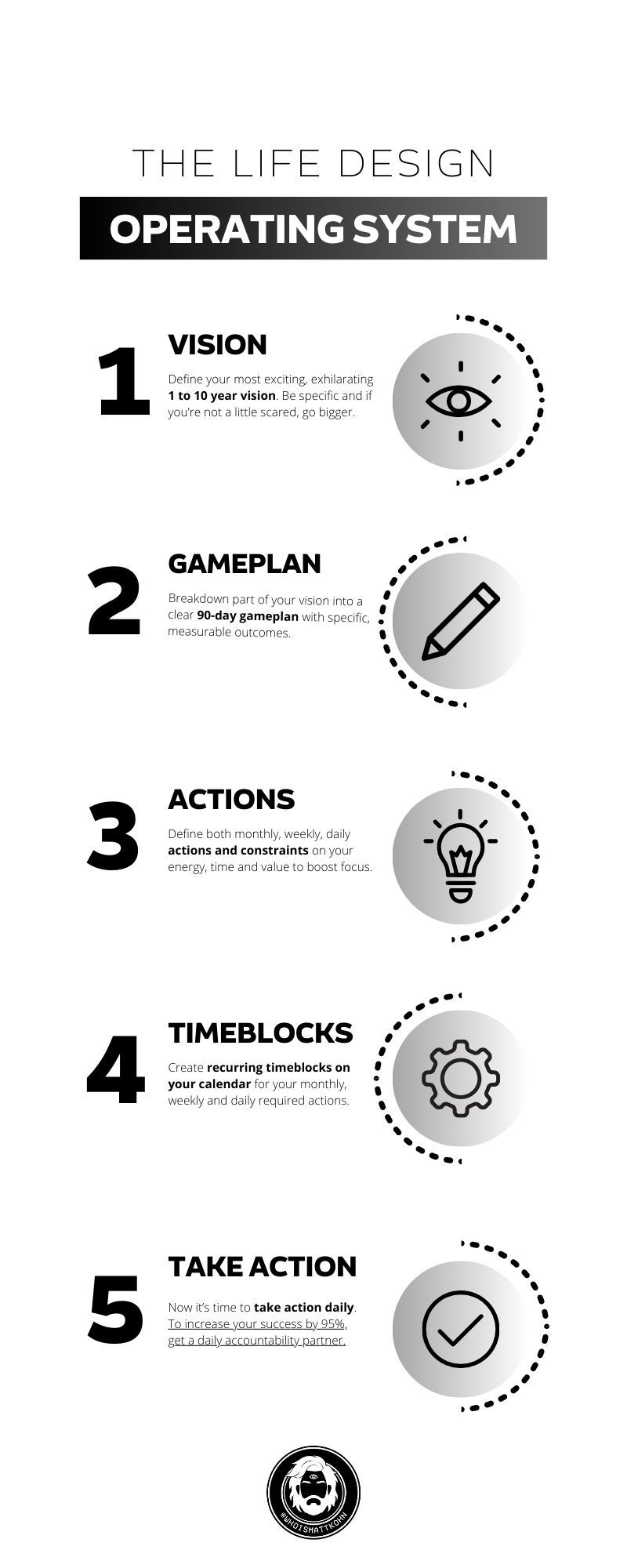The Life Design OS: How to Live the Life You've Always Wanted

In this post, I want to reveal an operating system that absolutely transformed my life forever and I hope it does the same for you.
I can attribute virtually every major milestone in my life in the last decade. These are some of the milestones I'm most proud of:
- I overcame crippling anxiety, burn out and depression multiple times
- I got accepted into two top 20 universities (Emory and Johns Hopkins University) despite my ADHD and being the world's laziest student
- I quit my 9 to 5, moved abroad and went full time on my business
- I traveled to 18 countries and lived on 3 continents
- I found and married my ride or die life partner / sugamama Anamaria :)
- I bootstrapped multiple companies (my design agency, growth advisory plus a partner firm) from 0 to 100s of clients and/or $1M in sales
- Most incredibly: I became a Dad !
Six months ago Anamaria and I welcomed our sweet baby boy Noah Vicente into the world. Despite being unable to speak, he has already taught me so much about life. I can't imagine what the next few months and years will bring.
The human body, the entire birthing process and life in general is a miracle. Having Noah has served as a reminder to refocus on what truly matters and be more intentional with every moment.
I no longer have time to waste and must be as intentional as possible with every moment of each day.
These last six months with Noah has inspired me to refine how I live so that I can continue to grow in life and business without sacrificing my peace or time with the most important people in my life.
With that, I am honored to bring you the latest iteration of The Life Design OS. I take no credit for developing this system as I have inherited this from my mentor and applied my own style.
However, this system is proven and is the same one I have used with hundreds of founders to help them go full time on their dreams and drive over $30 million in collective revenue to their businesses.
If you want a teaser, here's an infographic of the entire process start to finish.

1. Define Your 1-10 Year Vision
The universe will give you whatever you ask for but you have to ask. Not only that, but you need to make that ask as specific as possible.
Most importantly, have fun and remember if your vision isn’t a little scary, it’s not big or exciting enough.
2. Define Your 90-Day Gameplan
Now that we have your long-term vision defined, it’s time to break part of that vision into a clear 90-day gameplan. This gameplan must include the following elements:
- At least one, maximum three specific, measurable objectives (ie. get in the best shape of my life)
- an intrinsically motivating purpose (ie. This will allow me to feel more confident and become a healthier version of myself so that I can live a longer life with my family and friends)
- Metrics to track (ie. lose 12 pounds)
- gameplan (ie. hire a fitness coach, set daily reminders to work out, define my macros, download myfitnesspal and input my goals, etc.) that breaks down the objectives into strategic plans and projects
- Deadline by when your objective is due for completion.
- A motivating reward to look forward to once you complete the objective
3. Define Monthly, Weekly and Daily Actions
Once you have defined your 90 day objectives and gameplan, it’s time to break it down further into specific monthly, weekly and daily actions.
4. Set Energy, Time and Value Constraints
This is one of the most overlooked parts of the process but easily the most important. Not setting constraints is a recipe for failure and burnout. Constraints increase focus, creativity and productivity.
To maximize your effectiveness and chances of achieving your objectives, it is critical to set constraints on the 3 things that matter: your energy, time and value created.
Time Constraints
When it comes to time constraints, the limits of our physical body has provided the constraints. The upper limit for deep work is four hours per day (todoist). After this, our ability to direct focused attention diminishes. This is constraint number one.
Science also tells us that everybody has different optimal times to wake up, perform at your best and go to sleep. This is referred to as your chronotype and is constraint number two.
Read more about chronotypes and complete the chronotype quiz here, then fill out the below table.
Chronotype Definition
Once you have identified your chronotype and completed the table above, you will have a clear understanding of how to structure your day.
Daily Work Limit
Consistency is more important than intensity. Designing your ideal life means that you are not constantly on the brink of burnout. It means that you have carefully created your days to flow.
This may sound counterintuitive but science says that the more you work, the less productive you are. This means setting limits to your work hours dramatically increases productivity for several reasons.
One of the most compelling is Parkinson’s Law which states that work expands to fill the time available for its completion. Simply having a hard deadline forces you to get sh!t done.
This video does a great job breaking down this phenomenon: The Most Overlooked Productivity Superpower
All this being said, it’s important that you pick a daily work limit that you can do consistently do at least 4 to 7 days per week, every week without teetering on the brink of burn out. Be realistic and if needed, adjust as you go.
Energy Constraints
To live your best life, you want to spend as much of your time as possible doing things that bring you energy and avoiding things that drain your energy. The best way to do this is to define your zone of genius. Complete the boxes below to map out which types of activities energize and deplete you.
Zone of Genius Definition Exercise
Fill out the box below and for each activity NOT in your zone of genius, brainstorm ways to either delete it or delegate it.
Value Constraints
The number one reason why so few people ever live the lives they want is because they spend time being busy on the wrong things instead of the high impact, high value activities that significantly move the needle. Naval Ravikant is popularized this concept which he calls setting an ‘aspirational hourly rate’.
In order to set your value constraints, we need to define your target hourly value so that we can ruthlessly avoid spending time on all activities that fall below this value.
Target Hourly Value (THV) Calculation
Use the spreadsheet below to calculate your THV. The first row includes an example filled out for you.
Define Your Do and Do Not Do Tasks
Based on your newly defined target hourly value, think of all the tasks that you do on a daily and weekly basis and add them to the “DO” column or the “DO NOT DO” column.
Refer to the below example task value reference table to help you with this.
Example Task Value Reference Table
5. Design Your Perfect Day and Week
By now you should have a crystal clear 1-10 year vision, 90 day gameplan with actions to take on a monthly/weekly/daily basis as well as how to constrain your time, value and energy for maximum results.
The final step is to convert all of this data into designing your perfect day complete with timeblocks for optimal performance.
Create Your Daily, Weekly and Monthly Scorecards
Your scorecards are the checklist of items that you are responsible for completing on a recurring basis. Complete the table below to create your scorecards for your habits and objectives-based activities.
Create Timeblocks for Your Priorities
After defining all your scorecard activities, make sure to allocate your time while keeping your constraints in mind (4 hours max per day of focused work and your target hourly value).
Schedule Your Perfect Day and Week
- Write down your ideal wake time
- Write down your ideal focused worktime (limit this to 4 hours max)
- Write down your ideal bedtime
- Fill in your remaining activities